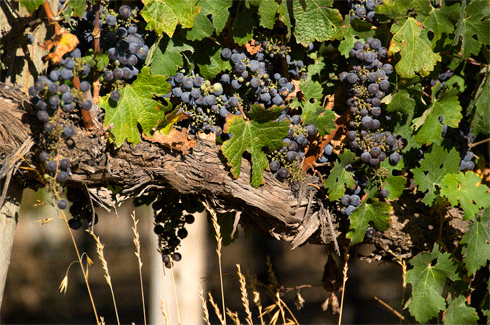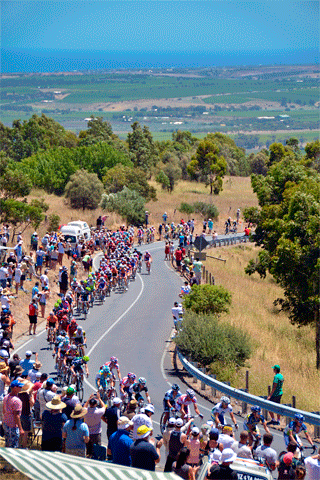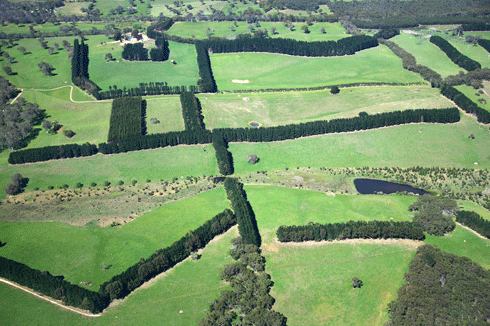
|
Published: 4 July 2011
Science helps SA farm communities adapt to change
Agriculture is one of the industries most at risk from climate change in Australia. Much of our agriculture occurs on marginal country with increasingly unreliable rainfall and irrigation supplies. Add volatile commodity prices, increased global demand, rising energy costs, increased demands on land managers to protect the environment and biodiversity, new land uses such as biomass, and an emerging carbon market, and it’s clear that Australian farming must change.
The Climate Change, Communities and Environment (3CE) project aims to help farmers and land managers make scientifically informed decisions about their futures. It is amassing a huge data bank across a range of disciplines that will be used to help farmers visualise how their regions could look under different climate scenarios.
The project is a joint effort by the University of Adelaide, CSIRO and the South Australian government. Project director and Chair of Natural Resource Science at the University of Adelaide, Professor Wayne Meyer, has an audacious vision of a renewable Australian landscape. He sees a landscape that is used for production, but is also in energy, nutrient and water balance: a landscape that retains its biodiversity and supports its regional community. This is a long way from the current reality of our landscape, but Prof. Meyer argues that what is needed is transformational change. He says improvement in human wellbeing will be the project’s measure of success.
The project focuses on two regions of South Australia – the Lower Murray and the Eyre Peninsula – using a tool called landscape futures analysis.
The Lower Murray region is defined by the Murray River. It is largely an irrigation community, which has faced changes in water availability as well as a warming, drying climate. The Eyre Peninsula is pastoral country that has experienced several decades of highly variable rainfall.
‘Farming techniques helped them adapt,’ Prof. Meyer explains. But, he says it is also country with a ‘fabulous coastline, aquaculture and national parks: diversity they could potentially use, if they are going to plan for the near and long-term future’. Prof. Meyer thinks that in a world of nine billion people, this combination of space, coastline and production is ‘going to become incredibly valuable’.
The 3CE project is built on the Lower Murray Landscape Futures, a ‘very ambitious’ effort Prof. Meyer steered while in CSIRO’s Water for a Healthy Country Flagship. He admits to being disappointed with the impact of the Lower Murray Landscapes Futures project, and believes the key to developing a better future is to provide a compelling vision of it. One way to do that is through landscape futures analysis.
Dr Brett Bryan, a principal research scientist with CSIRO, is amassing a wide range of data for the 3CE project – from socio-economic to ecology and production.
‘All these information layers are related by their geography,’ he explains. ‘We try and find those areas that are most efficient, most cost-effective for land use change.’
The project uses a series of maps to indicate what landscapes could look like under a range of scenarios, including the impact on food, water, biodiversity and land under different levels of climate change. It also looks at the impact of different carbon prices on landscapes as farmers switch from crops to biofuels and increased carbon sequestration.
‘There are some very competitive new alternate land uses that can have benefits for carbon, energy, biodiversity and soils, but they have tradeoffs,’ Dr Bryan points out. ‘They reduce the amount of food and fibre you can produce. They use water. All these things need to be considered in a robust decision-making environment based on evidence.’

|
|
Grapes are among the current crops grown in South Australia’s Riverina. Credit: SATC
|
Dr Bryan’s work shows large areas of opportunity under carbon prices of more than $20 per tonne. But he cautions that this is not a prediction, as he has not been able to factor in every variable. ‘People don’t switch instantaneously,’ he says. ‘There is uncertainty and risk around contracts, payments and markets.’
The Department of Climate Change and Energy Efficiency estimates that between 2011 and 2020, the switch to carbon planting could take place on between 15?000 and 30?000 hectares per year,1 a very small portion of the 469 million hectares used for agriculture.2
But the graphics focus the conversation. ‘The nexus between population, energy and food price is very, very influential,’ says Dr Bryan. ‘Carbon price is also very influential. They reflect changing demand and social preferences. How as a society do we make a decision on balance?’
The 3CE project is also looking at biodiversity. Dr Bryan says the traditional conservation model of buying a reserve will be less relevant as species shift in response to changing land use and climate.
‘We need to increase the permeability of agricultural land for native species, so they can actually move to new habitats. You can make some big conservation gains for very little money if you are opportunistic about it,’ suggests Dr Bryan.
Mr David Davenport, a senior consultant in soil and land management from Rural Solutions SA, thinks that modifying current farming practices will be one challenge.
‘I suspect that there will be some areas in the Eyre Peninsula where transformational processes will have to occur,’ he says. ‘We won’t be able to manage in the long term with just tinkering with what we currently do.’
Mr Davenport points out that the Eyre Peninsula is home to many innovative farmers with good access to information, knowledge and uptake. But, he thinks the key challenge will be finding the right avenues to bring it back to the community.
‘This is where natural resources management (NRM) boards are going to be instrumental,’ he says.
The 3CE project will be delivered through local NRM boards, which were set up in 2005 to drive ecologically sustainable development of South Australia’s natural resources.
Ms Cecilia Woolford, a member of the Eyre Peninsula NRM Board, farms grains and sheep on 1800 hectares near Kimba. She says the Board became a partner in the project two years ago, ‘because we have climate change as the absolute filter for all of the investment of the Board’.
Ms Woolford thinks the new maps will be vital. ‘I am really confident we will be able to take stuff and say, “OK, what is going to happen in Kimba?”’ she says.
Her property has been through six years of drought and low commodity prices in the past decade. Now her farm is entering the second good year ‘in a long, long time’, she has some serious decisions to make.
The short-term decisions, such as what grain to plant, are straightforward. But, a big question mark hangs over the future management of 400 hectares that Ms Woolford describes as ‘marginal’.
‘I am hoping the information I get from 3CE will allow me to say, do I go to a biodiverse planting and hence look at the carbon, or do I go to a mono planting like mallee oil trees, or do I actually decide that this isn’t going to be a farm anymore,’ she explains.
The project has another year to run before it can give the farmers of Eyre Peninsula and the Lower Murray the information they need to make vital decisions about their future. Prof. Meyer has every faith that farmers and land managers can adapt to the changes that are already upon them.
‘We are going to have to do some things that are quite different from what we have been doing, and I would like to think we could do that in a much more planned and conscious way,’ he says. ‘Ignorance is no longer an excuse.’
More information
Climate Change, Communities and Environment: www.adelaide.edu.au/environment/lfp/research/psrf.html
Landscape Futures: www.landscapefutures.com.au
Bryan BA et al (2007) Lower Murray Landscape Futures Dryland Component: Volume 3 – Preliminary Analysis and Modelling. CSIRO Water for a Healthy Country. www.tinyurl.com/dryland-modelling
1 Carbon Farming Initiative, Preliminary estimates of abatement: tinyurl.com/carbon-farming
2 Australia’s agriculture industries 2008 at a glance: adl.brs.gov.au/brsShop/data/ataglance2008_updated.pdf





